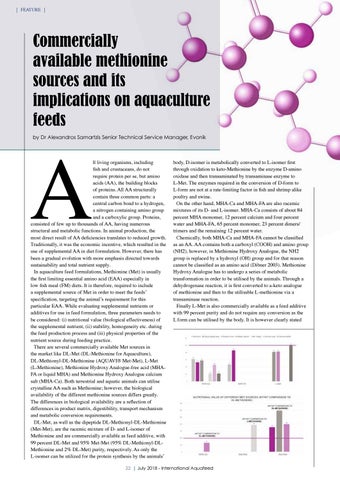FEATURE
Commercially available methionine sources and its implications on aquaculture feeds
A
by Dr Alexandros Samartzis Senior Technical Service Manager, Evonik
ll living organisms, including fish and crustaceans, do not require protein per se, but amino acids (AA), the building blocks of proteins. All AA structurally contain three common parts: a central carbon bond to a hydrogen, a nitrogen containing amino group and a carboxylic group. Proteins, consisted of few up to thousands of AA, having numerous structural and metabolic functions. In animal production, the most direct result of AA deficiencies translates to reduced growth. Traditionally, it was the economic incentive, which resulted in the use of supplemental AA in diet formulation. However, there has been a gradual evolution with more emphasis directed towards sustainability and total nutrient supply. In aquaculture feed formulations, Methionine (Met) is usually the first limiting essential amino acid (EAA) especially in low fish meal (FM) diets. It is therefore, required to include a supplemental source of Met in order to meet the feeds’ specification, targeting the animal’s requirement for this particular EAA. While evaluating supplemental nutrients or additives for use in feed formulation, three parameters needs to be considered: (i) nutritional value (biological effectiveness) of the supplemental nutrient, (ii) stability, homogeneity etc. during the feed production process and (iii) physical properties of the nutrient source during feeding practice. There are several commercially available Met sources in the market like DL-Met (DL-Methionine for Aquaculture), DL-Methionyl-DL-Methionine (AQUAVI® Met-Met), L-Met (L-Methionine), Methionine Hydroxy Analogue-free acid (MHAFA or liquid MHA) and Methionine Hydroxy Analogue calcium salt (MHA-Ca). Both terrestrial and aquatic animals can utilise crystalline AA such as Methionine; however, the biological availability of the different methionine sources differs greatly. The differences in biological availability are a reflection of differences in product matrix, digestibility, transport mechanism and metabolic conversion requirements. DL-Met, as well as the dipeptide DL-Methionyl-DL-Methionine (Met-Met), are the racemic mixture of D- and L-isomer of Methionine and are commercially available as feed additive, with 99 percent DL-Met and 95% Met-Met (95% DL-Methionyl-DLMethionine and 2% DL-Met) purity, respectively. As only the L-isomer can be utilized for the protein synthesis by the animals’
body, D-isomer is metabolically converted to L-isomer first through oxidation to keto-Methionine by the enzyme D-amino oxidase and then transaminated by transaminase enzyme to L-Met. The enzymes required in the conversion of D-form to L-form are not at a rate-limiting factor in fish and shrimp alike poultry and swine. On the other hand, MHA-Ca and MHA-FA are also racemic mixtures of its D- and L-isomer. MHA-Ca consists of about 84 percent MHA monomer, 12 percent calcium and four percent water and MHA-FA, 65 percent monomer, 23 percent dimers/ trimers and the remaining 12 percent water. Chemically, both MHA-Ca and MHA-FA cannot be classified as an AA. AA contains both a carboxyl (COOH) and amino group (NH2), however, in Methionine Hydroxy Analogue, the NH2 group is replaced by a hydroxyl (OH) group and for that reason cannot be classified as an amino acid (Dibner 2003). Methionine Hydroxy Analogue has to undergo a series of metabolic transformation in order to be utilised by the animals. Through a dehydrogenase reaction, it is first converted to a-keto analogue of methionine and then to the utilisable L-methionine via a transaminase reaction. Finally L-Met is also commercially available as a feed additive with 99 percent purity and do not require any conversion as the L form can be utilised by the body. It is however clearly stated
22 | July 2018 - International Aquafeed
